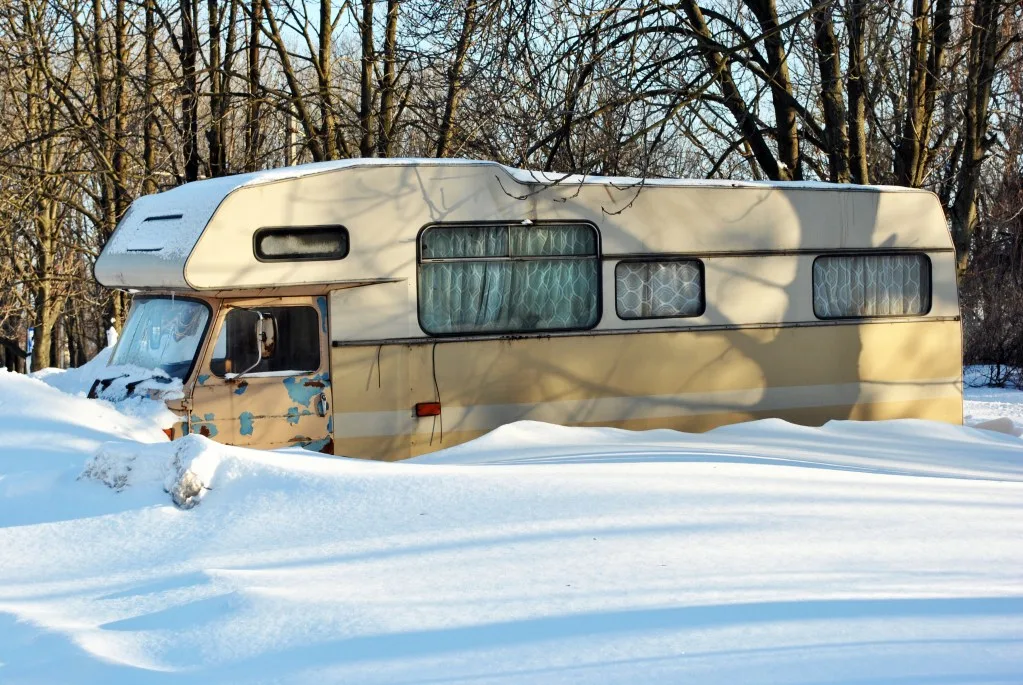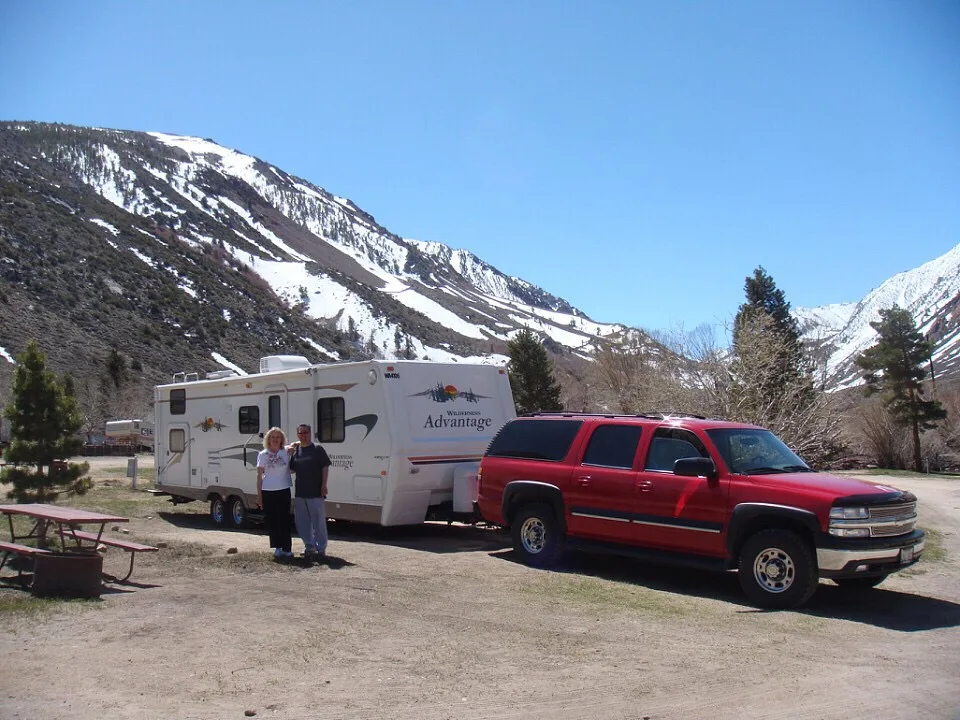Do You Need RV Skirting This Winter?
Extended exposure to freezing temps can really damage an RV. Not to mention, super cold temps will also make your RV nearly impossible to use.
Freezing pipes, freezing waste tanks, and a big chunk of ice in your freshwater tank is a recipe for disaster.
Most of us can figure out a way to deal with the cold, but RV aren’t always so adaptable.
What happens when that chill bites deep enough for the snow to fall and temperatures plunge? What happens when your water pipes and holding tanks freeze?
Before that happens, it’s time to consider RV skirting.
What is RV Skirting?
Simply put, RV skirting is some sort of material placed around the bottom of your camper to block cold air from the undercarriage.

3 Big Benefits of RV Skirting:
Protects Pipes and Tanks
The protection RV skirting affords your pipes and tanks is the primary reason for using it.
When the weather turns cold, below freezing cold, there is the likelihood that they could freeze. When the water inside of a pipe freezes, it expands, which could crack or otherwise damage your pipes or tanks.
RV skirting blocks cold air from flowing under your RV, helping to keep your pipes and tanks from freezing. It also allows for a closed area in which to apply warm air to further insure against the elements.

Keeps Whole RV Warmer and Saves on Propane
Another tremendous benefit of RV skirting is that it keeps the space under the floor of your RV warmer, which in turn keeps the inside of your RV much more comfortable.
When your RV is warmer, you have less need to fire up the furnace, which means less propane burned. Now you are staying warmer AND saving money because of the skirting.
Extra Storage
A bonus benefit of RV skirting is added storage space. Let’s face it. Most of us in RV’s have toys, etc., that are primarily made for summertime weather that get put away during the cold of winter.
When you do your RV skirting right, sealing off the underside of your rig, it is a great space for storing some of those summertime toys, affording you a little bit more inside space for those cold and blustery days inside.
Also, you’ll be able to more easily store your RV outside (instead of a pricey enclosed and heated RV storage unit).
Types of RV Skirting
DIY Method
You can make your own RV skirting out of materials like foam board, plywood, or vinyl. These can be effective, but doing it yourself is generally labor intensive, not easily portable, and may not look all that great.
Plywood is sturdy, fairly effective, and easy to find at just about any hardware store. It’s not the easiest thing to take apart and move though, plus it takes some tools and a little know how to make sure it is secure.
Foam board is lightweight and easier to install than plywood, but it’s not very durable and needs to be reinforced so it doesn’t get blown away under windy conditions.
Vinyl is one of the best options for RV skirting, whether as a DIY project or professionally made. Vinyl is highly customizable, able to seal the undercarriage well, lasts a long time, and is portable.
Know that there are some RV parks that might have restrictions against DIY RV skirting, usually because of how it looks.
EZ Snap Kit
As we said, vinyl is one of the best options for RV skirting. But unless you are an expert in vinyl, it can be a tall order to do your own vinyl skirting.
What we’ve found is one of the best, easiest, quickest, and most cost effective options if you go the vinyl route (highly recommended!!) is to purchase an EZ Snap Kit. It’s a great meet-somewhere-in-the-middle option for a handy do it yourselfer and a much more expensive and time consuming full custom skirt.
Using the EZ Snap website, you can use their calculator tool to determine what size skirt you need for your RV and what the cost will be. Because there is no need for you to go to them or for them to come to you on-site, the process is quick and relatively inexpensive.
EZ Snap has kits that fit any make, model or class of RV, Motorhome, Travel Trailer, Airstream and even tiny homes. You do the installation yourself. And when you are ready to pack up and go, you simply unsnap it, roll it up, and store it for next time.

Custom Skirting from RV Skirting
If you are prepared to go all-in for the creme de la creme option, RV Skirting in Peyton, Colorado, is the premier option.
When you choose RV Skirting, they create a skirt custom fit and designed to your specific rig. RV Skirting uses 18-ounce Rhino Tarp material, adjustable sewer zippers, longer length on the bottom, and a patented nail down strap system, amongst other details that make their skirts to the top of the line.
You’re not going with RV Skirting to save a buck, you are going with RV Skirting because every skirt they produce is perfect for that specific rig, so that set-up and teardown is as easy as possible and everything works seamlessly.
One drawback with fully custom RV skirting is that there is no on-line, mail-order option. This is tailor made, so you’ll need to go to RV Skirting in Colorado and be prepared to leave your rig with them for 2 days for a complete install.
If you can’t leave your rig, you can make an appointment for a Fit-N-Ship option, where you stop in for about 3 hours and then they’ll ship you the custom made skirt with instructions to install it yourself.
RV Skirting is a small family-owned business that takes great pride in their craft. If money isn’t of grave concern, you can’t go wrong with their custom designed skirting.
Do I Need RV Skirting This Winter?
Even if your rig is an all-weather or four-season RV or trailer, you may need skirting if you are going to be camping anywhere that could go into a deep freeze. Just because a rig is rated for all-weather doesn’t always tell the full tale when it comes to more extreme freezing conditions.
Regardless, most rigs are not rated for all-weather or four seasons. So if you are going to be in a location that faces the possibility of a deep freeze, RV skirting is a worthwhile investment. It’s certainly much cheaper, less messy, and less hassle than busted pipes and tanks.
There are plenty of reasons to consider some sort of RV skirting for your rig. Even if you may not need it, we still highly recommend it.
Protecting your pipes and tanks is the most important reason, but comfort, saving money on propane, keeping your water and sanitation functional when it gets cold out, and the convenience of a little extra storage all add up to some big benefits.
Even if you are flying south for the winter, unlikely to face below-freezing conditions, skirting is still a worthy consideration.
Pro Tip: Here’s an in depth look into when you need RV skirting.

Discover the Best Free Camping Across the USA
To be honest with you, we hate paying for camping. There are so many free campsites in America (with complete privacy).
You should give it a try!
As a matter of fact, these free campsites are yours. Every time you pay federal taxes, you’re contributing to these lands.
Become a FREE CAMPING INSIDER and join the 100,000 campers that love to score the best site!
We’ll send you the 50 Best Free Campsites in the USA (one per state). Access the list by submitting your email below:
Thankfully, we live in our 5th wheel in Florida, but I camped in a “lite” travel trailer years ago one winter in Missouri, and recall using visqueen sheeting and duct tape to cover underneath, winterize my pipes (and use campground facilities only), as well as put one of those outdoor mechanics lights underneath to help keep the concrete slab and underbelly of my little camper warm. It wasn’t insulated, so I had ice on the inside of my windows! Ha! Those were the days!